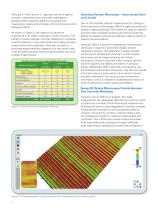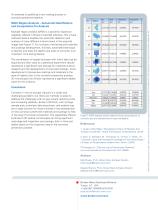
Corrosion Monitoring with Bruker 3D Optical Microscopes – Fast, Accurate Metrology for Cost Savings in the Refining Industry
1 /
5Pages
Catalog excerpts

Corrosion Pit with Trace 3D SEM-like Corrosion Application Note #556 Corrosion Monitoring with Bruker 3D Optical Microscopes – Fast, Accurate Metrology for Cost Savings in the Refining Industry Corrosion in the oil transport and refining industry degrades infrastructure and materials at a cost approaching $8 billion annually. Research scientists and engineers interested in oil production materials and additives, as well as how they influence the extent of and rates of corrosion, need fast and accurate methods to image and quantify structural damage. High quality images and accurate metrology enable workers to clearly document and trace changes over time in infrastructure, as well as to enable effective characterization of the influence of additives and other prevention techniques. Bruker’s 3D optical microscopes provide excellent large field-of-view images at high resolution, as well as highly accurate vertical scale information for the characterization of damaging corrosion. These imaging and metrology capabilities are exceptional tools for monitoring corrosion in the effort to help control or limit the detrimental effects of this inevitable material and environmental process. amounts of water and sediments do cause corrosion, causing leaks or failures over time. Also, heavy crude oil may have a higher acid or sulfur content, which is not problematic in the cool environment of the transportation pipeline, but acid and sulfur can become corrosive in the higher temperatures (200˚C, for example) of the refining environment. Finding and Fixing is not Ideal – How About an Ounce of Prevention? The pipeline environment is inspected regularly with ultrasonic pulse technologies or with mechanical inspection devices known as “intelligent pigs, which can help detect ” areas of heavier corrosion, such as that shown in Figure 1. Corrosion is Inevitable, But Controllable A key challenge corrosion presents in the oil refining industry is management of local area failures caused by pitting and fracturing in the surfaces. Crude oils under transport do not cause corrosion in the pipelines that deliver them (more than 2.5 million miles of pipeline in the United States alone). However, the inevitable presence of trace Figure 1. Internal pipeline corrosion shown. Pits, up to 10mm deep in some cases, ca
Open the catalog to page 1
Although a "find it and fix it” approach can work against corrosion, researchers are continually challenged to develop better materials, additives, and preventive measures to reduce and ultimately control corrosion and its damaging effects. As shown in Figure 2, the majority of preventive expenditure is on organic coatings to inhibit corrosion. The efficacy of these coatings, and their adherence to surfaces, must be tested on a very small scale using highly accurate measurement instrumentation. Although corrosion in controlled experimentation happens on a very small scale, it can be used to...
Open the catalog to page 2
Figure 4. Corrosion coupon samples. corrosion. With 3D analysis, hundreds of parameters can be calculated to fully describe surface corrosion, including the volume of material lost over time, ratios of peaks to valleys, directionality of corrosion, and so on. Bruker has developed targeted automation and analysis capabilities for our line of 3D optical microscopes that can mitigate cost and time issues associated with corrosion research and product development within the oil and gas industries. Bruker microscopes can dramatically increase the speed with which engineers and scientists can...
Open the catalog to page 3
The evaluation of corrosion coupons is a basic and widely used method of corrosion monitoring because they produce some of the most reliable physical corrosion evidence possible. They yield information on average material loss, corrosion rate, extent, distribution of localized corrosion, and the nature of the corrosion. Coupon corrosion results can identify trends that indicate acceptable or unacceptable corrosion protection, gains made by changes to a treatment program, or the need for improvements in protection or inspection programs or processes. Figure 6a. Measurement of small...
Open the catalog to page 4
An example is qualifying a new coating process or corrosion-preventive additive. Multi-Region Analysis - Automatic Identification and Computation for Analysis Multiple region analysis (MRA) is a powerful inspection capability offered in Bruker's Vision64 software. This unique software feature enables the automatic detection and analysis of many different interest areas in the acquired image (see Figure 7). For corrosion monitoring and materials and coatings development, this fast, automated technique to identify and track the depths and sizes of corrosion is an important, time saving...
Open the catalog to page 5All Bruker Nano Surfaces catalogs and technical brochures
-
MultiMode 8-HR
8 Pages
-
Dimension Icon SSRM
2 Pages
-
AutoMet AFM Software
2 Pages
-
MBT STAR-BL Software
4 Pages
-
MALDI Biotyper CA System
8 Pages
-
PRIME
12 Pages
-
rapifleX MALDI Tissuetyper
8 Pages
-
The new autoflex speed
10 Pages
-
MALDI PharmaPulse HTS
4 Pages
-
microflex
6 Pages
-
BioScope Resolve
8 Pages
-
AFM Dimension Edge
8 Pages
-
Dimension FastScan Bio
4 Pages
-
Dimension Icon
6 Pages
-
MultiMode 8 Brochure
8 Pages
-
Innova
8 Pages
-
Dimension FastScan
8 Pages

























